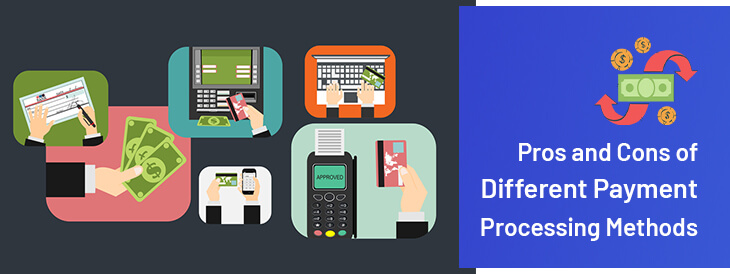Pros and Cons of Different Payment Processing Methods
Pros and Cons of Different Payment Processing Methods

Choosing the right payment processing method is a critical decision for businesses of all sizes. As it can significantly impact customer experience, operational efficiency, and overall profitability. Various payment processing options are available, each with its own set of advantages and disadvantages.
Traditional credit and debit card processing might offer convenience and trustworthiness, but they can also come with high fees and lengthy settlement times. On the other hand, high-risk payment methods, often necessary for industries like gaming or adult entertainment. Can provide flexibility and access to a broader customer base, albeit with increased scrutiny and potentially higher costs.
As businesses navigate these options, understanding the pros and cons of each method is essential for making informed choices that align with their specific needs and risk tolerance. This exploration aims to shed light on the diverse landscape of payment processing, helping you determine the best fit for your business while mitigating any potential pitfalls.
The Reliability and Reach of Traditional Credit Card Payments
Traditional credit card payments have long been a cornerstone of commerce due to their widespread acceptance and ease of use. Virtually every customer is familiar with this payment method, making it a reliable option for businesses looking to ensure seamless transactions. Credit cards offer a level of trust that can enhance customer confidence, as they are often backed by fraud protection measures and secure payment gateways.
One significant advantage is the broad reach of credit card payments. Businesses can accept payments from customers around the world, facilitating international sales and expanding their market reach. The infrastructure supporting credit card transactions is robust, with well-established networks and reliable processing times. Which helps minimize disruptions in service.
However, the reliability and reach of credit card payments come at a cost. Merchant fees can be high, eating into profit margins, particularly for small businesses. Additionally, the risk of chargebacks and fraud can pose significant challenges, requiring stringent security measures and diligent monitoring. Despite these drawbacks, the ubiquity and trustworthiness of traditional credit card payments make them an indispensable component of many businesses’ payment processing strategies.
Some Related Blogs
- Finding the Right Kratom Merchant Account
- Essential Tips for Kratom Credit Card Processing Success
- Simplifying Payment Processing for Travel Agencies: Key Options
- Top Benefits of a Sports Betting Merchant Account
Benefits and Drawbacks of Using Mobile Wallets
Mobile wallets, such as Apple Pay, Google Wallet, and Samsung Pay, have gained popularity due to their convenience and ease of use. These digital wallets allow customers to store their credit card information on their smartphones, enabling quick and secure transactions with just a tap. One of the key benefits of mobile wallets is their enhanced security features, including tokenization and biometric authentication. Wwhich reduce the risk of fraud and unauthorized access.
The convenience factor cannot be overstated; customers can make purchases without carrying physical cards or cash, streamlining the checkout process. This can lead to increased customer satisfaction and potentially higher sales for businesses. Additionally, mobile wallets often integrate seamlessly with loyalty programs and promotional offers, providing a more personalized shopping experience.
However, despite these advantages, there are some drawbacks to consider. The adoption rate of mobile wallets can vary significantly across different demographics, with some customers being hesitant to embrace new technology. Additionally, not all merchants are equipped to accept mobile wallet payments, which can limit their utility.
Technical issues, such as compatibility problems or software glitches, can also pose challenges. While mobile wallets offer significant benefits, businesses need to weigh these against potential limitations and customer preferences.
The Cost-Effectiveness and Challenges of Bank Transfers
Bank transfers, including ACH (Automated Clearing House) payments and wire transfers, are often praised for their cost-effectiveness, particularly for larger transactions. Unlike credit card payments, which incur percentage-based fees, bank transfers typically have flat-rate fees that can be more economical for high-value transactions. This can be a significant advantage for businesses that handle substantial payments regularly.
Another benefit of bank transfers is their security. Banks employ stringent verification processes to ensure that funds are transferred securely, which can minimize the risk of fraud. Additionally, bank transfers can be a preferred method for recurring payments, as they allow for direct debits from customer accounts, streamlining the billing process for subscription-based services.
Despite these benefits, there are challenges associated with bank transfers. One major drawback is the slower processing time, as ACH payments can take several days to clear. This can impact cash flow, especially for businesses that rely on quick access to funds.
Wire transfers, while faster, can be expensive, particularly for international transactions. Furthermore, initiating bank transfers can require more effort from customers, who must manually enter banking details, which could lead to errors and a less convenient payment experience.
![]()
Email us anytime!
Email customer service 24/7 at info@binarygateways.com
![]()
Call us anytime!
Reach customer care 24/7 at (801) 761-5001
